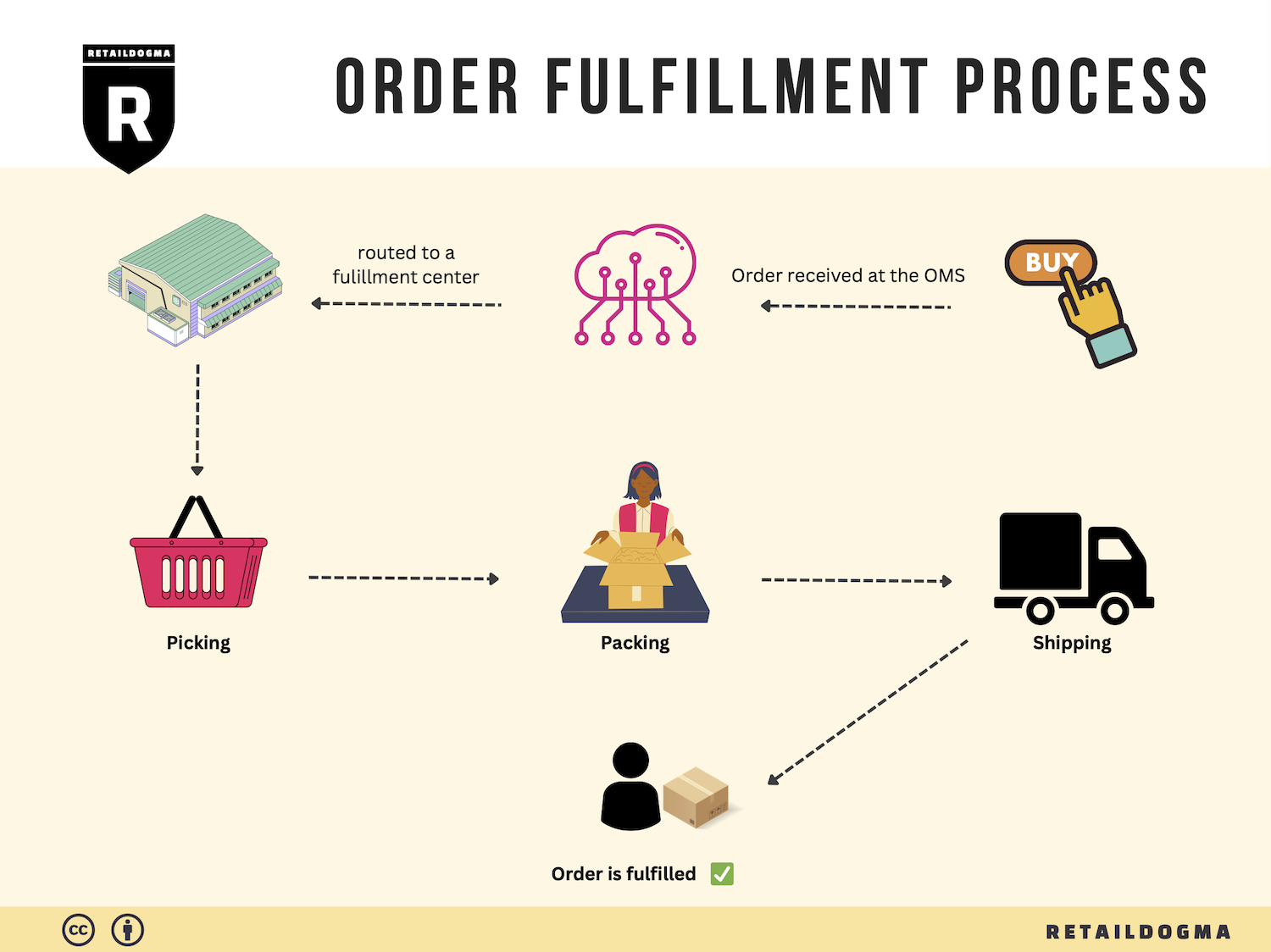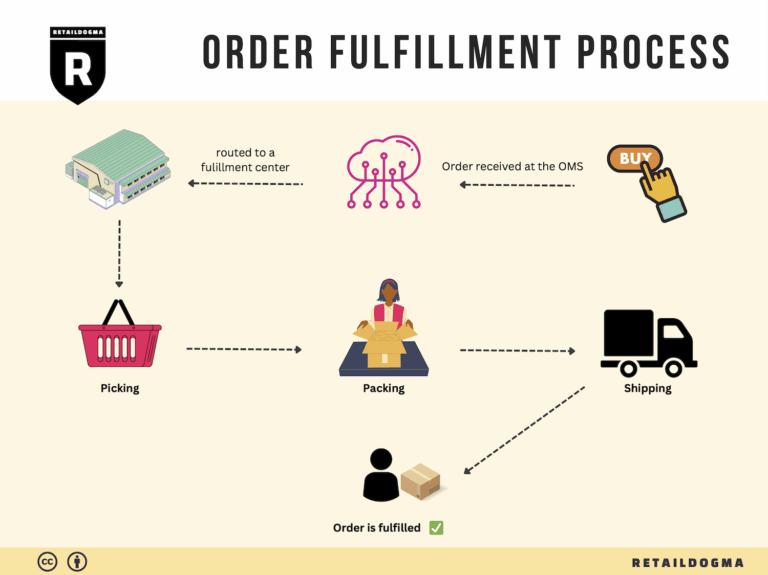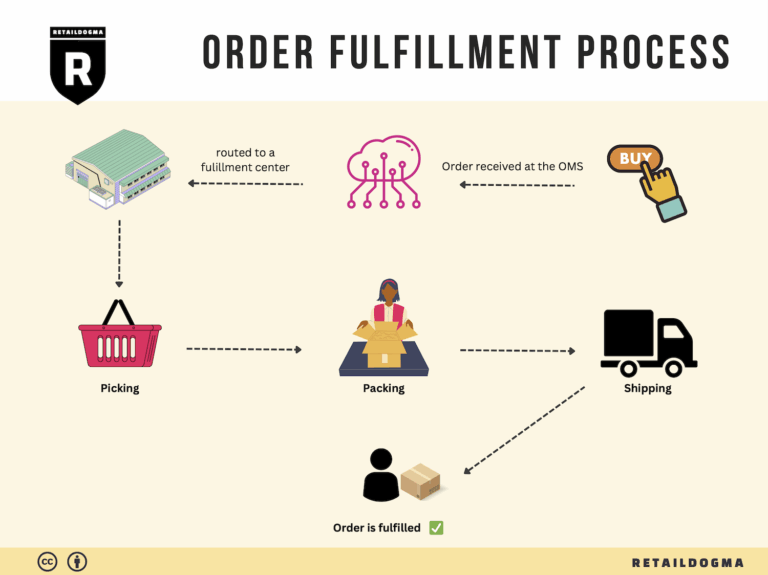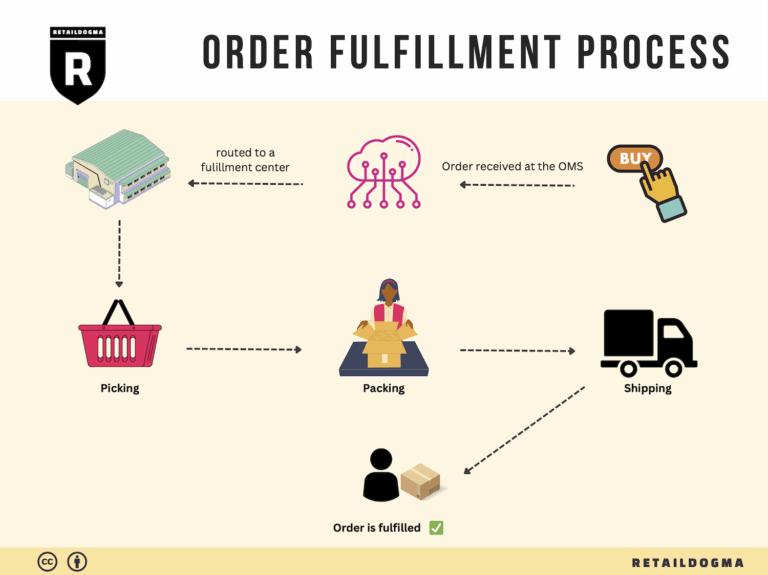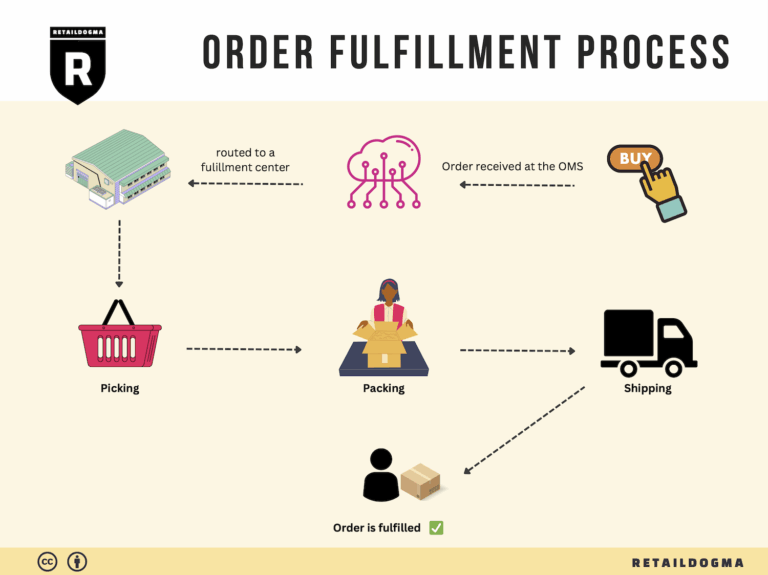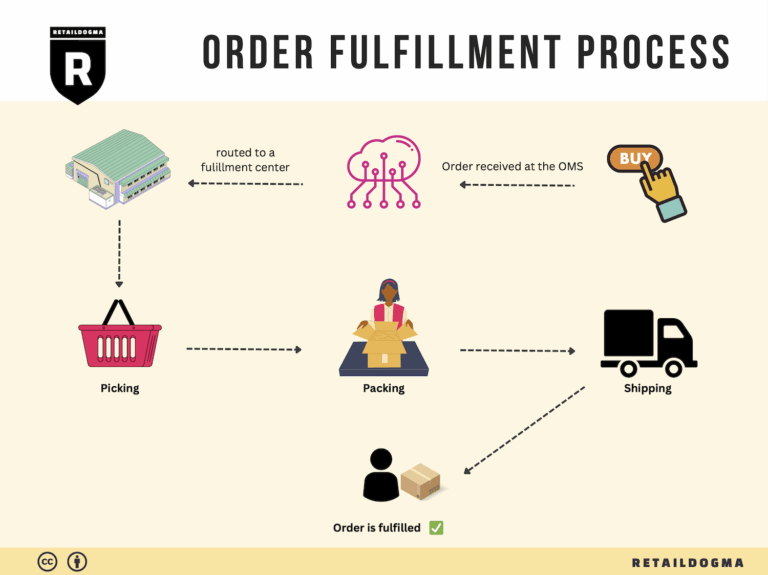Ecommerce Fulfillment Services: The Ultimate Guide (2025)
What is E-commerce Fulfillment? An Introduction for Growing Businesses
Understanding E-commerce Fulfillment: A Key to Scaling Your Business
As a growing online business, one of the most common pain points you may encounter is the overwhelming task of packing and shipping orders. The thrill of making sales can quickly turn into a logistical nightmare as you juggle inventory management, packaging, and timely deliveries. This is where e-commerce fulfillment comes into play, serving as a crucial element in delivering your products efficiently to your customers.
E-commerce fulfillment can be defined simply as the process of getting a product from your warehouse or fulfillment center to the customer’s doorstep. This process encompasses a series of steps, including inventory storage, order processing, packaging, and shipping. For businesses looking to scale, understanding and optimizing this process is vital for maintaining customer satisfaction and operational efficiency.
In this guide, we will explore various fulfillment models that can suit your business’s needs. From traditional in-house fulfillment to outsourcing to third-party logistics (3PL) providers, and utilizing Amazon’s Fulfillment by Amazon (FBA) services, we’ll break down the pros and cons of each option. You’ll learn about the core services offered by these fulfillment partners, which typically include inventory management, order processing, shipping, and returns handling.
Choosing the right fulfillment partner is another critical aspect we will cover. We’ll provide practical criteria to evaluate potential partners, including their technology capabilities, scalability, customer service, and geographical reach. Understanding pricing structures is equally important; we will discuss factors that influence costs, such as storage fees, shipping rates, and service charges, enabling you to make informed decisions.
The ultimate goal of this guide is to empower you to make smart, strategic decisions about your logistics operations. By demystifying the fulfillment process and providing you with actionable insights, you can streamline your operations, reduce overhead costs, and focus on what you do best—growing your business. Whether you’re just starting or looking to enhance your existing logistics strategy, understanding e-commerce fulfillment is key to delivering a seamless customer experience and achieving long-term success.
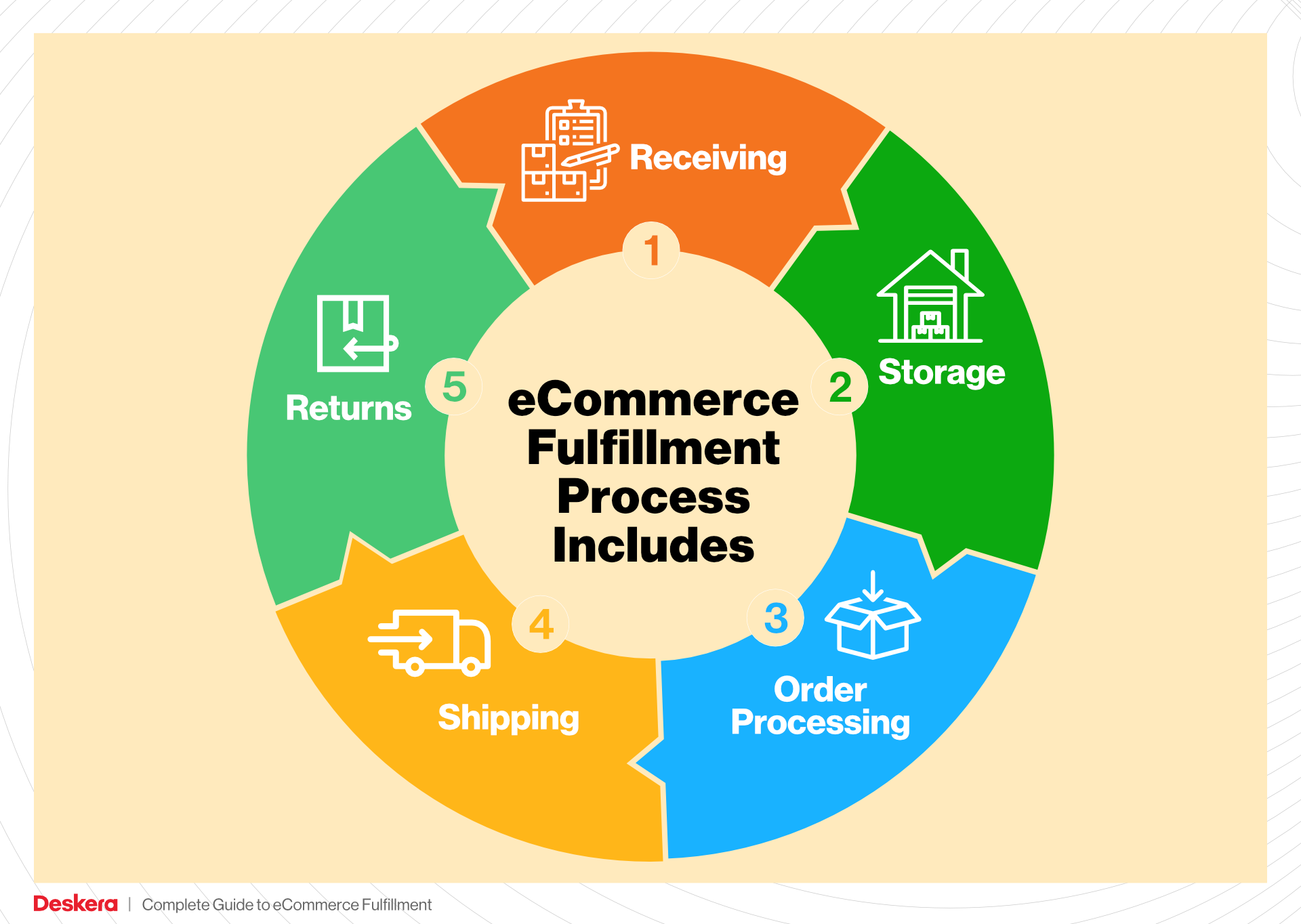
What You’ll Learn In This Guide
- What is E-commerce Fulfillment? An Introduction for Growing Businesses
- The Order Fulfillment Process: From ‘Buy’ Button to Customer’s Door
- Comparing Fulfillment Models: In-House vs. 3PL vs. Dropshipping
- A Deep Dive into Amazon FBA: Pros, Cons, and Who It’s For
- Core Services Offered by Fulfillment Centers
- How to Choose a Fulfillment Partner: A 6-Point Checklist
- Understanding Fulfillment Pricing: A Breakdown of Common Fees
- Frequently Asked Questions (FAQs) about Fulfillment
- Conclusion: Is Outsourcing Fulfillment the Right Move for Your Business?
- Important Disclaimer
The Order Fulfillment Process: From ‘Buy’ Button to Customer’s Door
1. Receiving Inventory
The order fulfillment process begins with receiving inventory at the fulfillment center. When products arrive, they are checked against purchase orders to confirm that the correct items and quantities have been delivered. This step is critical as it ensures accuracy in stock levels and helps prevent future discrepancies.
During this phase, products are assigned a Stock Keeping Unit (SKU), a unique identifier that streamlines inventory management. Each SKU allows for easy tracking of product quantities and sales, which is essential for maintaining optimal stock levels. Efficient receiving procedures can significantly reduce the time products spend in transit and increase the speed at which they become available for order fulfillment.
2. Warehouse Storage
Once the inventory is received and verified, it is stored in the warehouse. The organization of this storage is crucial for maximizing efficiency during the picking process. Products may be stored in specific locations based on their demand, size, or category, following either random or fixed location strategies.
Effective warehouse storage not only optimizes space but also ensures that items can be easily located when an order is placed. The implementation of a Warehouse Management System (WMS) can greatly enhance this process by providing real-time data on inventory levels and locations. This system helps in reducing the time spent searching for items, ultimately speeding up the overall fulfillment process.
3. Order Picking
When a customer places an order, the next step is order picking. This involves selecting items from their storage locations based on a pick list, which details the SKUs and quantities required for each order. Efficient picking is essential for maintaining customer satisfaction, as delays in this step can lead to longer delivery times.
There are various picking methods, including single order picking, batch picking, and zone picking, each with its own advantages depending on the volume and type of products being handled. Implementing a robust picking strategy can enhance accuracy and speed, thus reducing the risk of errors that could lead to order returns or customer dissatisfaction.

4. Order Packing
After picking, the next step is order packing. This process involves carefully packing the selected items for shipment to ensure they arrive at the customer’s door in perfect condition. Proper packing is vital to protect products during transit and to provide an excellent unboxing experience for customers.
During this phase, packing slips are generated, and items may be bundled together based on order specifications. The use of packing materials, such as bubble wrap and boxes, should be optimized to minimize shipping costs while ensuring product safety. Additionally, incorporating branded packaging can enhance brand visibility and customer loyalty.
5. Shipping & Delivery
The final step in the order fulfillment process is shipping and delivery. Once the order is packed, it is labeled and handed over to a carrier for delivery. This step is crucial as it directly impacts the customer’s experience. Timely and accurate delivery can significantly enhance customer satisfaction and foster repeat business.
Shipping methods may vary based on customer preferences and costs, including standard, expedited, or same-day delivery options. Tracking systems are also implemented to provide customers with real-time updates on their order status, which is increasingly expected in today’s e-commerce landscape. Efficient shipping practices, such as route optimization and carrier management, can lead to cost savings and improved delivery times, thus contributing to overall business scalability.
By understanding and optimizing each of these five steps in the order fulfillment process, e-commerce businesses can enhance their operational efficiency and improve customer satisfaction, ultimately positioning themselves for scalable growth in a competitive marketplace.

Comparing Fulfillment Models: In-House vs. 3PL vs. Dropshipping
Fulfillment Model Comparison
| Model | Who Handles Inventory | Best For (Business Stage) | Key Advantage | Key Disadvantage |
|---|---|---|---|---|
| In-House Fulfillment | Your business | Established businesses | Complete control over inventory | High operational costs |
| Third-Party Logistics (3PL) | 3PL provider | Growing businesses | Scalable and cost-effective | Less control over operations |
| Dropshipping | Supplier/Manufacturer | Startups and small businesses | Low startup costs | Lower profit margins |
In-House Fulfillment
In-house fulfillment refers to the practice of managing all aspects of inventory storage, order processing, and shipping within your own facilities. Businesses that opt for this model typically have established operations and a steady volume of sales, allowing them to invest in warehousing and logistics capabilities. The primary advantage of in-house fulfillment is the complete control it offers over inventory management, order accuracy, and customer service. Companies can tailor their processes to fit specific business needs, ensuring a unique customer experience.
However, this model comes with significant disadvantages. The operational costs can be high due to expenses associated with warehouse leasing, staff salaries, and inventory management systems. Additionally, in-house fulfillment requires a substantial investment in infrastructure and technology, which can be a barrier for smaller businesses. As a company scales, the complexity of managing logistics can also increase, necessitating additional resources and expertise.
Third-Party Logistics (3PL)
Third-party logistics (3PL) providers offer outsourced logistics services, allowing businesses to focus on core activities while leaving the complexities of storage and shipping to specialists. This model is particularly advantageous for growing businesses that experience fluctuating order volumes. By partnering with a 3PL, businesses can scale their operations without the burden of managing logistics infrastructure.
One of the key advantages of using a 3PL is cost-effectiveness. Companies can avoid the high upfront costs associated with in-house fulfillment by leveraging the 3PL’s existing resources, such as warehouses and distribution networks. Moreover, 3PLs often have established relationships with carriers, which can lead to better shipping rates and faster delivery times. However, the major downside is the reduced control over the fulfillment process. Businesses may experience challenges in maintaining quality standards, and any issues with the 3PL can directly impact customer satisfaction. Effective communication and partnership are essential to ensure that the 3PL aligns with the company’s values and service expectations.
Dropshipping
Dropshipping is a fulfillment model where a business sells products without holding inventory. Instead, when a customer places an order, the retailer purchases the item from a third party, who then ships it directly to the customer. This model is particularly appealing for startups and small businesses due to its low startup costs and minimal financial risk. Entrepreneurs can launch an online store without the need for significant investment in inventory or warehousing.
The key advantage of dropshipping is the low barrier to entry; business owners can test new products and markets without the commitment of upfront inventory purchases. This flexibility allows for rapid iteration and adaptation to market demands. However, dropshipping also comes with challenges, such as lower profit margins and reduced control over shipping times and product quality. Businesses must rely on suppliers for inventory management and fulfillment, which can lead to issues if the supplier fails to meet expectations. Additionally, the competitive landscape in dropshipping can drive down prices and make it difficult to differentiate one’s offerings.
In summary, each fulfillment model presents unique advantages and disadvantages that can impact your e-commerce operations. Understanding these differences is crucial for making informed decisions as you scale your business.
A Deep Dive into Amazon FBA: Pros, Cons, and Who It’s For
Understanding Fulfillment by Amazon (FBA)
Fulfillment by Amazon (FBA) is a service provided by Amazon that allows sellers to store their products in Amazon’s fulfillment centers. Amazon takes care of storage, packaging, and shipping of products directly to customers. This service is designed to simplify the logistics process for sellers, enabling them to focus more on growing their business rather than managing inventory and shipping operations.
How FBA Works
-
Product Listing: Sellers create product listings on Amazon and choose FBA as their fulfillment method. They prepare their products for shipping to Amazon’s fulfillment centers.
-
Shipping to Amazon: Sellers send their inventory to one or more of Amazon’s warehouses. The BFI9 fulfillment center, located in DuPont, Washington, is one of many strategic locations across the U.S. that help optimize shipping times and costs.
-
Storage: Once the products arrive at the fulfillment center, they are stored until sold. Amazon manages the inventory and keeps track of stock levels.
-
Order Processing: When a customer places an order, Amazon picks, packs, and ships the product on behalf of the seller. They also handle customer service inquiries and returns.
-
Customer Delivery: Amazon ensures fast delivery, often utilizing its Prime service to offer expedited shipping options.
-
Payment: After the sale, Amazon deducts its fees and transfers the remaining funds to the seller’s account, typically every two weeks.
Pros of Using FBA
1. Prime Eligibility
One of the most significant advantages of FBA is that products become eligible for Amazon Prime. This means that Prime members can receive products with free two-day shipping, which can significantly boost sales and visibility.
2. Increased Customer Trust
Products fulfilled by Amazon are often perceived as more reliable by customers. The backing of Amazon’s brand and their customer service increases buyer confidence, which can lead to higher conversion rates.
3. Multi-Channel Fulfillment
FBA isn’t limited to Amazon.com sales. Sellers can use FBA to fulfill orders from other sales channels, such as their own websites or other marketplaces. This provides a seamless way to manage inventory across various platforms without the need for additional logistics setups.
4. Time Savings
By outsourcing fulfillment to Amazon, sellers can focus on other aspects of their business, such as marketing, product development, and customer engagement. This can lead to more efficient operations and potential growth.
5. Scalability
FBA allows businesses to scale quickly. As demand increases, sellers can send more inventory to Amazon without needing to invest in additional warehouse space or logistics resources.
Cons of Using FBA
1. High Fees
FBA comes with a variety of fees, including storage fees for inventory and fulfillment fees based on the size and weight of products. These costs can add up, especially for smaller sellers or those with lower-margin products, impacting profitability.
2. Strict Inventory Rules
Amazon has specific guidelines regarding inventory management, including limits on the number of units that can be sent to fulfillment centers. Failure to comply can result in penalties, including removal of inventory or suspension of selling privileges.
3. Commingling Risks
FBA uses a commingled inventory system, meaning that sellers’ products are stored alongside those of other sellers. This can lead to issues if products are damaged or if there are quality control problems. A seller might receive negative feedback due to issues stemming from another seller’s products.
4. Less Control Over Fulfillment
While outsourcing fulfillment can be beneficial, it also means that sellers have less control over the shipping process and customer experience. Delays or errors in fulfillment can reflect poorly on the seller.
5. Complexity of Returns
Managing returns through FBA can be complicated. While Amazon handles returns for customers, sellers must adhere to Amazon’s policies, which may not always align with their business practices.
Who is FBA Best For?
Fulfillment by Amazon is ideal for e-commerce business owners and entrepreneurs looking to scale their operations without the overhead associated with managing logistics. It is particularly suited for:
- Small to Medium-Sized Businesses: Those who want to leverage Amazon’s massive customer base and logistics network without investing heavily in infrastructure.
- Sellers with High-Volume Products: Products that can benefit from the fast shipping and customer trust associated with FBA.
- Brands Seeking Prime Visibility: Sellers looking to increase their market presence and attract Prime members will find FBA beneficial.
- Multi-Channel Sellers: Businesses that sell on multiple platforms and want a centralized fulfillment solution can effectively utilize FBA to streamline operations.
In conclusion, while FBA offers numerous advantages, including access to Amazon’s vast logistics network and increased customer trust, it is essential for sellers to weigh these benefits against the potential downsides. Understanding the implications of using FBA will help sellers make informed decisions that align with their business goals and operational capabilities.
Core Services Offered by Fulfillment Centers
Inventory Management & Warehousing
Inventory management and warehousing form the backbone of any fulfillment center’s operations. This service involves the systematic tracking of products from the moment they arrive at the warehouse until they are shipped to customers. Fulfillment centers utilize sophisticated inventory management systems that provide real-time visibility into stock levels, product locations, and order statuses.
Benefits for E-commerce Businesses:
-
Optimized Stock Levels: By efficiently managing inventory, businesses can avoid overstocking or stockouts, ensuring they meet customer demand without incurring unnecessary costs.
-
Reduced Storage Costs: Fulfillment centers often have scalable storage solutions that allow e-commerce businesses to pay only for the space they need, thus minimizing overhead expenses.
-
Improved Order Accuracy: Advanced inventory management systems reduce human error, ensuring that the right products are picked and shipped to customers.
-
Data Insights: Businesses gain valuable insights into sales trends and inventory turnover, enabling informed decision-making regarding purchasing and marketing strategies.
Pick and Pack Services
Pick and pack services refer to the process of selecting ordered items from the warehouse and packaging them for shipment. This service is essential for e-commerce businesses, as it directly impacts order fulfillment speed and accuracy. Fulfillment centers employ skilled staff and advanced technology to ensure that orders are picked efficiently and packed securely.
Benefits for E-commerce Businesses:
-
Faster Fulfillment: With dedicated teams for picking and packing, fulfillment centers can significantly reduce the time it takes to process orders, leading to quicker delivery times that enhance customer satisfaction.
-
Customized Packaging Solutions: Fulfillment centers can offer various packaging options, including branded materials, which can enhance the customer experience and promote brand identity.
-
Scalability: During peak seasons, such as holidays, fulfillment centers can ramp up operations to handle increased order volumes without the need for businesses to invest in additional staffing or infrastructure.
-
Quality Control: Many fulfillment centers implement strict quality control measures to ensure that the right items are picked and packed correctly, reducing the likelihood of returns due to errors.
Kitting and Assembly
Kitting and assembly services involve combining multiple products into a single package or assembling products before they are shipped. This service is particularly useful for businesses that offer bundled products or require specific configurations for items.
Benefits for E-commerce Businesses:
-
Enhanced Product Offerings: Kitting allows businesses to create unique product bundles that can attract customers and differentiate them from competitors.
-
Reduced Time to Market: By outsourcing assembly tasks to fulfillment centers, businesses can focus on core activities such as marketing and sales, speeding up the time it takes to launch new products.
-
Cost Efficiency: Fulfillment centers often have the expertise and resources to assemble products more efficiently than in-house teams, leading to cost savings.
-
Streamlined Operations: Combining products at a fulfillment center simplifies logistics, as businesses can ship a single package instead of multiple items, reducing shipping costs and improving customer convenience.
Returns Management (Reverse Logistics)
Returns management, or reverse logistics, is the process of handling products that customers return. This service is critical in the e-commerce space, where return rates can be significantly higher than in traditional retail. Fulfillment centers manage returns efficiently by inspecting, restocking, or disposing of returned items.
Benefits for E-commerce Businesses:
-
Improved Customer Satisfaction: A streamlined returns process can enhance the customer experience, encouraging repeat business and positive reviews.
-
Cost Reduction: By efficiently managing returns, businesses can minimize losses associated with returned merchandise and reduce the costs of processing returns.
-
Data Collection: Analyzing return data can provide insights into product quality, customer preferences, and potential areas for improvement in sales strategies.
-
Inventory Management: Fulfillment centers can quickly reintegrate returned items into inventory, ensuring that products are available for resale and minimizing the impact of returns on stock levels.
By leveraging the core services offered by fulfillment centers, e-commerce businesses can enhance their operational efficiency, improve customer satisfaction, and ultimately drive growth in a competitive market. These services not only streamline logistics but also allow business owners to focus on scaling their operations without being bogged down by the complexities of warehousing and order fulfillment.
How to Choose a Fulfillment Partner: A 6-Point Checklist
Location & Warehouse Network
Importance: The geographical location of your fulfillment partner’s warehouses can significantly affect shipping times and costs. A partner with strategically placed warehouses can facilitate quicker delivery to your customers, which is crucial for maintaining high service levels.
Questions to Ask:
– Where are your warehouses located, and how does this align with our target customer demographics?
– What is the average shipping time from your warehouses to major markets we serve?
– Can you accommodate our specific shipping needs (e.g., local deliveries, international shipping)?
Technology & Integrations
Importance: In today’s fast-paced e-commerce environment, robust technology is essential for seamless operations. A fulfillment partner should provide advanced technology that integrates easily with your existing systems (such as e-commerce platforms, inventory management software, and accounting tools).
Questions to Ask:
– What technology do you use for inventory management and order fulfillment?
– Can your system integrate with our existing platforms? If so, what is the process?
– Do you provide real-time tracking for orders, and how can we access this information?
Specializations (e.g., Cold Storage, Oversized Items)
Importance: Depending on your product types, you may need a fulfillment partner with specific capabilities. Whether you require cold storage for perishables or specialized handling for oversized items, it’s crucial to ensure that the partner can meet these needs.
Questions to Ask:
– What types of products do you specialize in handling?
– Do you have facilities for specialized storage needs (e.g., cold storage, hazardous materials)?
– How do you ensure compliance with regulations related to our product types?
Scalability & Capacity
Importance: As your business grows, your fulfillment needs will likely change. A good fulfillment partner should be able to scale operations quickly to accommodate increased demand, whether due to seasonal spikes or overall business growth.
Questions to Ask:
– How do you handle peak seasons or unexpected surges in order volume?
– What is your current capacity, and how quickly can you expand if needed?
– Can you provide case studies or examples of how you have scaled for other clients?
Pricing and Contracts
Importance: Understanding the pricing structure and contract terms is vital for budgeting and long-term planning. Look for transparency in pricing and be wary of hidden fees that could affect your bottom line.
Questions to Ask:
– What are your pricing models (e.g., per order, monthly subscription, tiered pricing)?
– Are there any hidden fees we should be aware of (e.g., storage fees, pick and pack fees)?
– What are the terms of your contract, and is there flexibility for adjustments as our business needs change?
Customer Support & Reviews
Importance: Exceptional customer support can be a game-changer in logistics and fulfillment. The responsiveness and reliability of your fulfillment partner can directly impact your customer experience and, by extension, your brand reputation.
Questions to Ask:
– What kind of customer support do you offer (e.g., 24/7 support, dedicated account manager)?
– How do you handle issues such as lost or damaged shipments?
– Can you provide references or reviews from other clients in our industry?
Conclusion
Choosing the right fulfillment partner is a critical decision that can significantly affect your e-commerce business’s efficiency, customer satisfaction, and overall success. By carefully evaluating potential partners against this checklist, you can ensure that you select a fulfillment solution that aligns with your business goals and operational needs. Always remember to conduct thorough research and don’t hesitate to ask for clarifications on any aspect of their services. The right partner will be transparent, communicative, and committed to supporting your growth.
Understanding Fulfillment Pricing: A Breakdown of Common Fees
Initial Setup Fees
When partnering with a fulfillment center, the initial setup fees represent the costs associated with onboarding your business. These fees can include account setup, system integration, and training for your team on using the fulfillment platform. The specifics of these charges can vary widely among providers, but they often range from a few hundred to several thousand dollars, depending on the complexity of your operations and the services included.
To calculate initial setup fees, consider the following factors:
– Complexity of Integration: Custom integrations with your e-commerce platform or ERP system may incur higher costs.
– Volume of Products: A larger inventory can lead to higher setup fees due to additional time and resources needed.
– Training Requirements: If your team requires extensive training, this will add to the overall costs.
Receiving Fees
Receiving fees are charged when your products arrive at the fulfillment center. These fees cover the labor and resources required to unload, inspect, and store your products. Typically, fulfillment centers charge based on the volume of goods received, often calculated per pallet or per unit.
Factors influencing the calculation of receiving fees include:
– Product Type: Items that require special handling (fragile, perishable, etc.) may incur higher fees.
– Volume: Higher volumes can sometimes lead to discounts, while low-volume shipments might be charged a minimum fee.
– Condition of Goods: If products arrive damaged or require additional quality checks, additional fees may apply.
Storage Fees (per pallet/bin)
Storage fees are charged for keeping your products in the fulfillment center. This fee is typically calculated on a monthly basis and can vary depending on the amount of space your inventory occupies, usually measured in pallets or bins.
Key considerations in storage fees include:
– Duration of Storage: Many fulfillment centers have tiered pricing based on how long products are stored. Longer storage times may incur higher fees.
– Seasonal Variations: During peak seasons (e.g., holidays), storage fees may increase due to higher demand for space.
– Product Turnover Rate: Slow-moving items may incur additional long-term storage fees, incentivizing businesses to manage inventory turnover effectively.
Pick & Pack Fees (per item/order)
Pick and pack fees are incurred each time an order is processed and shipped. This fee generally covers the labor for picking items from inventory, packing them appropriately, and preparing them for shipment. It is often calculated per item or per order, depending on the fulfillment center’s pricing structure.
When evaluating pick and pack fees, consider:
– Order Complexity: Orders with multiple items or special packing requirements (gift wrapping, for instance) may incur higher fees.
– Volume Discounts: Fulfillment centers may offer discounts for businesses that process a higher volume of orders.
– Shipping Method: The choice of shipping method can also affect the packing process and associated costs.
Shipping Fees
Shipping fees are the charges for transporting orders from the fulfillment center to the customer. These fees can vary significantly based on factors such as destination, package weight, and shipping speed. Fulfillment centers often have partnerships with carriers, which can influence the rates they offer.
Key factors in calculating shipping fees include:
– Shipping Carrier: Different carriers have different pricing structures, and fulfillment centers may pass these costs on to you.
– Shipping Zones: Costs can vary depending on how far the package is traveling; longer distances generally incur higher fees.
– Package Dimensions and Weight: Heavier and larger packages typically incur higher shipping costs.
Tips for Getting an Accurate Quote
- Understand Your Needs: Clearly outline your business requirements, including estimated volumes and types of products, to ensure the provider can offer a tailored solution.
- Request Detailed Breakdowns: Ask potential fulfillment partners for a detailed breakdown of all fees, including any potential hidden costs.
- Compare Multiple Providers: Don’t settle for the first quote; compare several fulfillment centers to find the best combination of pricing and services.
- Inquire About Discounts: Some fulfillment centers may offer discounts for long-term contracts or higher volumes; always ask.
- Review Contracts Carefully: Ensure you fully understand the terms and conditions related to fees, especially regarding variable charges that may change over time.
By understanding these common fulfillment pricing models and their calculations, e-commerce business owners can make informed decisions that align with their operational strategies and financial goals.
Frequently Asked Questions (FAQs) about Fulfillment
1. What is BFI9 and where is it located?
BFI9 is an Amazon Fulfillment Center located in DuPont, Washington, with the postal code 98327. It serves as a key hub in Amazon’s logistics network, facilitating the storage and distribution of products to meet customer orders efficiently.
2. What services does Amazon BFI9 provide?
Amazon BFI9 offers a range of fulfillment services, including inventory storage, order processing, packaging, and shipping. It plays a crucial role in the “middle mile” of Amazon’s logistics, ensuring that products move from warehouses to customers promptly.
3. How does BFI9 fit into Amazon’s supply chain?
BFI9 is integral to Amazon’s supply chain, particularly in the “middle mile” phase. It stores products until they are ready to be shipped to various delivery stations or directly to customers, ensuring quick and efficient order fulfillment.
4. What’s the difference between a warehouse and a fulfillment center?
A warehouse is primarily a storage facility for goods, while a fulfillment center is specifically designed to handle the entire order fulfillment process, including picking, packing, and shipping orders to customers. Fulfillment centers like BFI9 focus on efficiency and speed to meet customer demands.
5. What is a 3PL (Third-Party Logistics)?
A 3PL is a service provider that manages logistics and supply chain operations for businesses. This includes warehousing, inventory management, order fulfillment, and transportation. Companies often use 3PLs to streamline their logistics and focus on core business activities.
6. How much do fulfillment services cost?
The cost of fulfillment services varies based on factors such as order volume, storage space required, and specific services used (like packaging and shipping). On average, businesses can expect to pay for storage fees, pick and pack fees, and shipping costs, which can range from a few dollars to several hundred per month, depending on the scale of operations.
7. How can I optimize my inventory management at BFI9?
To optimize inventory management at BFI9, businesses should regularly review stock levels, utilize Amazon’s inventory management tools, and implement forecasting techniques to anticipate demand. Keeping inventory levels aligned with sales trends can minimize storage costs and enhance fulfillment efficiency.
8. What are the benefits of using Amazon’s fulfillment services?
Utilizing Amazon’s fulfillment services, such as those at BFI9, offers several benefits, including faster shipping times, access to Amazon’s extensive logistics network, improved customer satisfaction, and reduced operational complexities. This allows businesses to focus more on growth and marketing.
9. Can I track my shipments from BFI9?
Yes, Amazon provides tracking capabilities for shipments processed through its fulfillment centers, including BFI9. Sellers can access tracking information via their Amazon Seller Central account, allowing them to monitor the status of their orders in real-time.
10. How do I get started with Amazon fulfillment at BFI9?
To get started with Amazon fulfillment at BFI9, you need to create an Amazon seller account and register for the Fulfillment by Amazon (FBA) program. After that, you can ship your products to BFI9, where they will be stored and fulfilled according to your sales orders. Be sure to familiarize yourself with Amazon’s guidelines for packaging and labeling to ensure a smooth process.
Conclusion: Is Outsourcing Fulfillment the Right Move for Your Business?
Evaluating the Benefits of Outsourcing Fulfillment
Outsourcing fulfillment can be a transformative decision for e-commerce businesses, particularly as they look to scale operations effectively. One of the primary benefits is time savings. By partnering with a dedicated fulfillment service, businesses can offload the complexities of inventory management, order processing, and shipping logistics. This allows entrepreneurs and operations managers to focus on core activities such as marketing, product development, and customer engagement, ultimately driving growth.
Scalability is another crucial advantage. As sales volume fluctuates, having a fulfillment partner enables businesses to adapt quickly without the need for substantial investments in infrastructure or workforce. Whether it’s handling seasonal spikes or expanding into new markets, a fulfillment service can provide the flexibility needed to meet changing demands without compromising service quality.
Moreover, leveraging the expertise of a fulfillment partner, such as those operating within Amazon’s BFI9 warehouse or similar facilities, can enhance operational efficiency. These partners are equipped with advanced technologies and systems designed to streamline processes, reduce errors, and improve delivery times. Their experience in logistics can also mitigate common challenges faced by growing businesses, such as managing returns or navigating complex shipping regulations.
Choosing the Right Partner for Growth
Selecting the right fulfillment partner is critical to ensuring your business can thrive in a competitive landscape. Look for partners who not only align with your operational needs but also share your vision for customer satisfaction and growth. Conducting thorough due diligence—such as assessing their capabilities, service levels, and customer reviews—can provide valuable insights.
Take Action
As you consider whether outsourcing fulfillment is the right move for your business, take a moment to audit your current shipping processes. Identify pain points, inefficiencies, and areas where a fulfillment partner could add value. This strategic assessment will empower you to make informed decisions that align with your growth objectives. By embracing the right fulfillment strategy, you can unlock new levels of efficiency and customer satisfaction that propel your business forward.
Important Disclaimer
⚠️ Important Disclaimer
The information in this guide is for educational purposes. Fulfillment services, pricing, and platform features change frequently. Always conduct your own due diligence and consult with providers directly before making business decisions.
